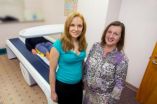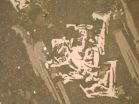(Press-News.org) TALLAHASSEE, Fla. – Florida State University researchers have identified a new syndrome called "osteosarcopenic obesity" that links the deterioration of bone density and muscle mass with obesity.
"It used to be the thinking that the heavier you were the better your bones would be because the bones were supporting more weight," said Jasminka Ilich-Ernst, the Hazel Stiebeling Professor of Nutrition at Florida State. "But, that's only true to a certain extent."
The syndrome, outlined in the May issue of Ageing Research Reviews, explains how many obese individuals experience a triad of problems that place them at a higher risk for falling and breaking bones.
Ilich-Ernst began looking at the connections between bone, muscle and fat mass a few years ago, realizing that most scientists were examining bone issues without taking into consideration muscle mass and strength, let alone fat tissue.
"Many factors impact bones," she said. "This developed as a logical way to move forward to look at everything together and not just focus on one area."
So, she went back and examined the files for 200 women who'd participated in previous studies where she'd measured their bone density, muscle mass and fat tissue for different reasons. About one-third had more than 30 percent fat tissue, plus declining bone density (osteopenia) and muscle mass (sarcopenia).
"This would be a triad problem for older women," Ilich-Ernst said. "They cannot perform as well. They cannot walk as fast. They cannot walk the stairs well or stand up and sit down multiple times without being winded or in pain."
People do tend to gain weight and lose both muscle mass and bone density with age, Ilich-Ernst acknowledged. But substantial gain in body fat can make the muscle and bone problems even worse.
"They have a higher risk of falling and breaking a bone or encountering other disabilities," she said.
Ilich-Ernst said the problem is most prevalent with older women, but that it could impact all ages and genders.
Overall, she said she hopes the research reminds people to consider the damage that can be done to all parts of the body if they are overweight.
"Everything is connected," she said.
INFORMATION:
Illich-Ernst was joined on the paper by her doctoral student, Julia Inglis, and fellow Florida State University faculty members Lynn Panton and Mike Ormsbee. Other co-authors included Owen Kelly, a research scientist at the Ohio-based Abbott Nutrition, and Gustavo Duque, a professor at the University of Sydney.
Researchers: Obesity can amplify bone and muscle loss
2014-04-16
ELSE PRESS RELEASES FROM THIS DATE:
Researchers develop a new drug to combat the measles
2014-04-16
A novel antiviral drug may protect people infected with the measles from getting sick and prevent them from spreading the virus to others, an international team of researchers says.
Scientists from the Institute for Biomedical Sciences at Georgia State University, the Emory Institute for Drug Development and the Paul-Ehrlich Institute in Germany developed the drug and tested it in animals infected with a virus closely related to one that causes the measles. As reported in the current issue of the journal Science Translational Medicine, virus levels were significantly ...
Celldex's Phase 1 study of CDX-1401 published in Science Translational Medicine
2014-04-16
HAMPTON, NJ (April 16, 2014): Celldex Therapeutics, Inc. (NASDAQ: CLDX) announced today that final data from its Phase 1 study of CDX-1401 in solid tumors, including long-term patient follow-up, have been published in Science Translational Medicine (Vol 6 Issue 232). The data demonstrate robust antibody and T cell responses and evidence of clinical benefit in patients with very advanced cancers and suggest that CDX-1401 may predispose patients to better outcomes on subsequent therapy with checkpoint inhibitors. CDX-1401 is an off-the-shelf vaccine consisting of a fully ...
Meteorites yield clues to red planet's early atmosphere
2014-04-16
Geologists who analyzed 40 meteorites that fell to Earth from Mars unlocked secrets of the Martian atmosphere hidden in the chemical signatures of these ancient rocks. Their study, published April 17 in the journal Nature, shows that the atmospheres of Mars and Earth diverged in important ways very early in the 4.6 billion year evolution of our solar system.
The results will help guide researchers' next steps in understanding whether life exists, or has ever existed, on Mars and how water—now absent from the Martian surface—flowed there in the past.
Heather Franz, ...
Mutant protein in muscle linked to neuromuscular disorder
2014-04-16
Sometimes known as Kennedy's disease, spinal and bulbar muscular atrophy (SBMA) is a rare inherited neuromuscular disorder characterized by slowly progressive muscle weakness and atrophy. Researchers have long considered it to be essentially an affliction of primary motor neurons – the cells in the spinal cord and brainstem that control muscle movement.
But in a new study published in the April 16, 2014 online issue of Neuron, a team of scientists at the University of California, San Diego School of Medicine say novel mouse studies indicate that mutant protein levels ...
Study provides crucial new information about how the ice ages came about
2014-04-16
An international team of scientists has discovered new relationships between deep-sea temperature and ice-volume changes to provide crucial new information about how the ice ages came about.
Researchers from the University of Southampton, the National Oceanography Centre and the Australian National University developed a new method for determining sea-level and deep-sea temperature variability over the past 5.3 million years. It provides new insight into the climatic relationships that caused the development of major ice-age cycles during the past two million years.
The ...
Searching for dark energy with neutrons
2014-04-16
All the particles we know to exist make up only about five per cent of the mass and energy of the universe. The rest – "Dark Matter" and "Dark Energy" – remains mysterious. A European collaboration lled by researchers from the Vienna University of Technology has now carried out extremely sensitive measurements of gravitational effects at very small distances at the Institut Laue-Langevin (ILL) in Grenoble. These experiments provide limits for possible new particles or fundamental forces, which are a hundred thousand times more restrictive than previous estimations.
Undiscovered ...
Ancient shark fossil reveals new insights into jaw evolution
2014-04-16
The skull of a newly discovered 325-million-year-old shark-like species suggests that early cartilaginous and bony fishes have more to tell us about the early evolution of jawed vertebrates—including humans—than do modern sharks, as was previously thought. The new study, led by scientists at the American Museum of Natural History, shows that living sharks are actually quite advanced in evolutionary terms, despite having retained their basic "sharkiness" over millions of years. The research is published today in the journal Nature.
"Sharks are traditionally thought to ...
Scientists re-define what's healthy in newest analysis for Human Microbiome Project
2014-04-16
ANN ARBOR, Mich. – As scientists catalog the trillions of bacteria found in every nook and cranny of the human body, a new look by the University of Michigan shows wide variation in the types of bacteria found in healthy people.
Based on their findings in today's
Nature, there is no single healthy microbiome. Rather each person harbors a unique and varied collection of bacteria that's the result of life history as well their interactions with the environment, diet and medication use.
"Understanding the diversity of community types and the mechanisms that result ...
Sperm meets egg: Protein essential for fertilization discovered
2014-04-16
Researchers at the Wellcome Trust Sanger Institute have discovered interacting proteins on the surface of the sperm and the egg essential to begin mammalian life. These proteins, which allow the sperm and egg to recognize one another, offer new paths towards improved fertility treatments and the development of new contraceptives.
Fertilisation occurs when an egg and a sperm recognise each other and fuse together to form an embryo. The Izumo protein displayed on the sperm that recognises the egg was identified in 2005 by Japanese researchers who named it Izumo, after a ...
Hide and seek: Revealing camouflaged bacteria
2014-04-16
A research team at the Biozentrum of the University of Basel has discovered an protein family that plays a central role in the fight against the bacterial pathogen Salmonella within the cells. The so called interferon-induced GTPases reveal and eliminate the bacterium's camouflage in the cell, enabling the cell to recognize the pathogen and to render it innocuous. The findings are published in the current issue of the science magazine Nature.
Bacteria have developed countless strategies to hide themselves in order to evade attack by the immune system. In the body, Salmonella ...






